From the late Neolithic Age (circa 3500 BC-2070 BC) into today the crafting of jade art objects in China has produced beautiful and magnificent art objects which exhibit remarkable diversity of both color and form as shown by the carved nephrite jade pendant with phoenix pattern and the funerary Bi Disc with rain pattern in Figure 1[Ref1]. In this blog I’ll describe the tools and techniques with their technological advances and show corresponding art objects of increasing complexities of design and execution.
As shown in Table 2 of Reference 1 as presented in Figure 1 below, shaping techniques, such as cutting, grinding, carving, drilling, piercing, carving to egg shell thinness, and polishing began in the Neolithic Age (approximately 10,000 BC-3000 BC[Ref2] and are still practiced today, with the benefit of improved technologies which have evolved over time.
The authors of Reference 2 propose the evolution of jade rotary carving tools to have proceeded over five generations as described in the text and summarized in Table 2 of the Reference.


First Generation Advances in Jade Carving, ~3500 BC – ~2070 BC[Ref2].
In the First Generation a primitive rotary jade carving machine first appeared in Neolithic Longshan[Ref2,3,4] and Liangjiatan (Liangzhu[Ref5]) cultural sites and featured tools surfaced with natural materials such as stone wood, and bone. Major features of the primitive carving machine allowed the operator to be seated and the fixed shaft of the tool to be manually rotated, both probably lending better control than that obtainable with hand held tools.
The cong shown in Figure 2, is a ritual vessel used in burials[Ref6]. It is an exceptional example of a nephrite jade object carved during the era of the Liangzhu Culture. The use of the surfaces and shaped edges of rotating grinding tools such as discs with abrasives in shaping and polishing of the structural features of the cong seems evident. Also the use of a rotating hollow tube with an abrasive in generating the eye features of the masks at the corners of the cong is evident . Use of the surfaces of small wheels with abrasives to generate relief curves such as those on edges and eyebrows of the mask also seems evident.

Second Generation Advances in Jade Carving ,~2070 BC- ~ 6 AD[Ref2]
Use of a bronze rotary machine began during the Xia and Shang Dynasties, 2700-1046 BC was in use to the early to mid-Chunqiu Period, 9~620 BC[Ref8,9.10]. Operators may have been kneeling and able to obtain higher rotational speed through the forward thrusting of both the upper body and arm rather than the use of the arm of seated person. Continued use of grinding tools with symmetric rotating forms is evidenced in the carved human face shown in Figure 3.

Third Generation Advances in Jade Carving, ~6th Century BC– ~581 AD[Ref2]
The manually driven iron rotary machine first appeared over the Chunqiu Period until the Nan-bei Dynasty, 770-589 BC[Ref10,12]. Operators still kneeled when using the machine. The newly developed iron grinding tools were sharper and maintained their sharpness and shapes longer than bronze tools. Finer detailed carving could be realized as shown by the carved jade sword sheath in figure . Use of iron tools enabled the appearance of Han badao carving in which deep narrow cuts were used to define the shape of carved objects such as the pigs shown in Figure 4. Burial suits in which small plates of jade are stitched together with metal wire as shown in Figure 6 appeared in the Han Dynasty (206 BC – 8 AD).


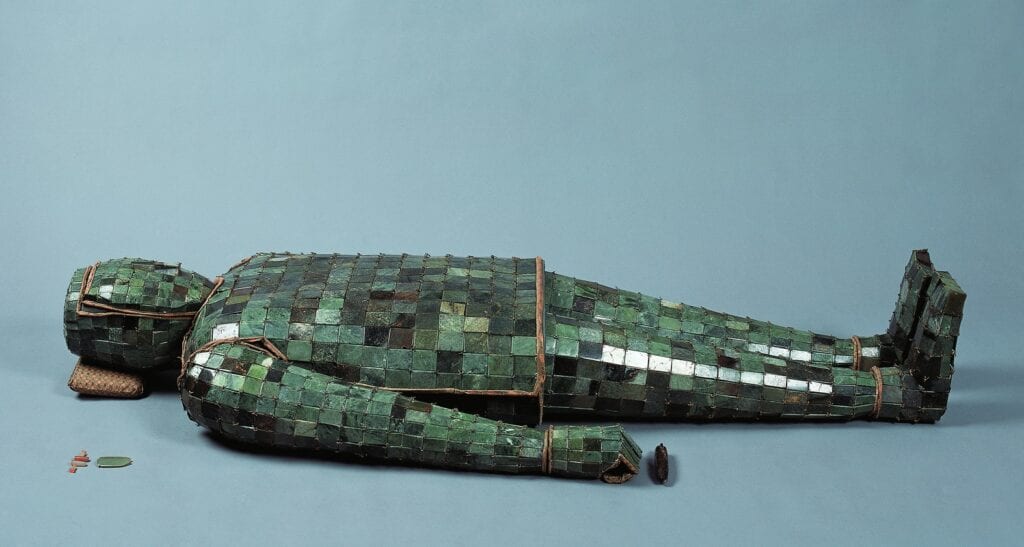
Fourth Generation Advances In Jade Carving, ~581-AD-1960 AD[Ref2]
The treadle-driven table-type iron rotary machine as shown in Figures – and – with tools as those in Figure – has been used from the Sui and Tang Dynasties, 581-618 AD and 618-907 AD[Ref 16,17] into the 1950s. the switch in seating followed the availability of indoor furniture. The use of the foot-driven treadle freed both hands for manipulation with finer control of the jade object during carving as evidenced by the carved lady and horse, respectively in Figures 7 and 8.





Fifth Generation Advances in Jade Carving,1960-Present[Ref2]
The modern rotary carving machine was first introduced in the 1960s and now takes the forms of a fixed or hand-held precision tool on a flexible shaft and a computer-controlled precision machine with motion in three mutually perpendicular directions and three mutually perpendicular rotary tools for carving complex 3-D shapes. Additionally the emergence of synthetic diamond and carborundum (silicon carbide) abrasives and polishing agents have enabled better tool performance. With the increased precision of tools a number of carving techniques flourished. Use of a modern rotary tool is shown in Figure 12 and a computer controlled machine in Figure 13.
Carved objects became more elaborate post 1960. Qiaose carving in which the carved form capitalizes on regions of color variation in the jade to enhance the aesthetics of the object, such as the carved jade Chinese cabbage shown in Figure was better enabled[Ref]. New precision rotary machines could be used to carve vessels with egg-shell thin walls and forms of egg-shel thickness as shown in Figures 15,16 and17. Use of the computer-controlled machine enabled carving of more complex patterns for inlay of gems in jade objects such as the Quing Dynasty white nephrite egg-shell bowl of Islamic style, 2010 shown in Figure [Ref2].
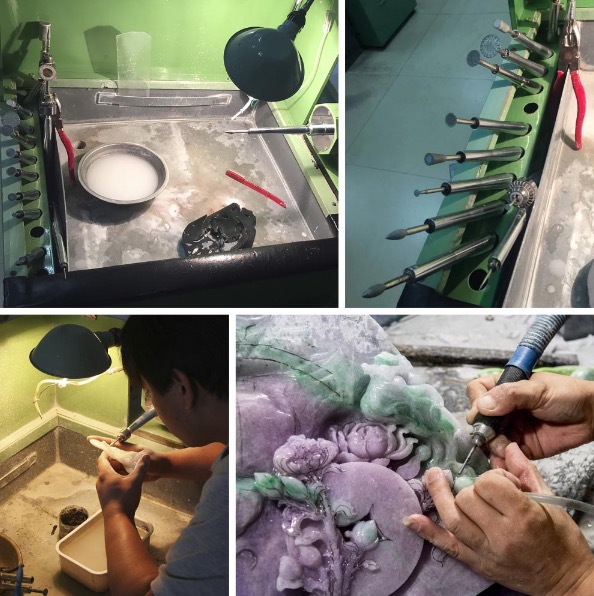
With use of the flexible shaft used withboth the position of the tool and object changeable as shown in the lower-right panel. Multishaped tools are shown in the panel on the upper right[Ref2].

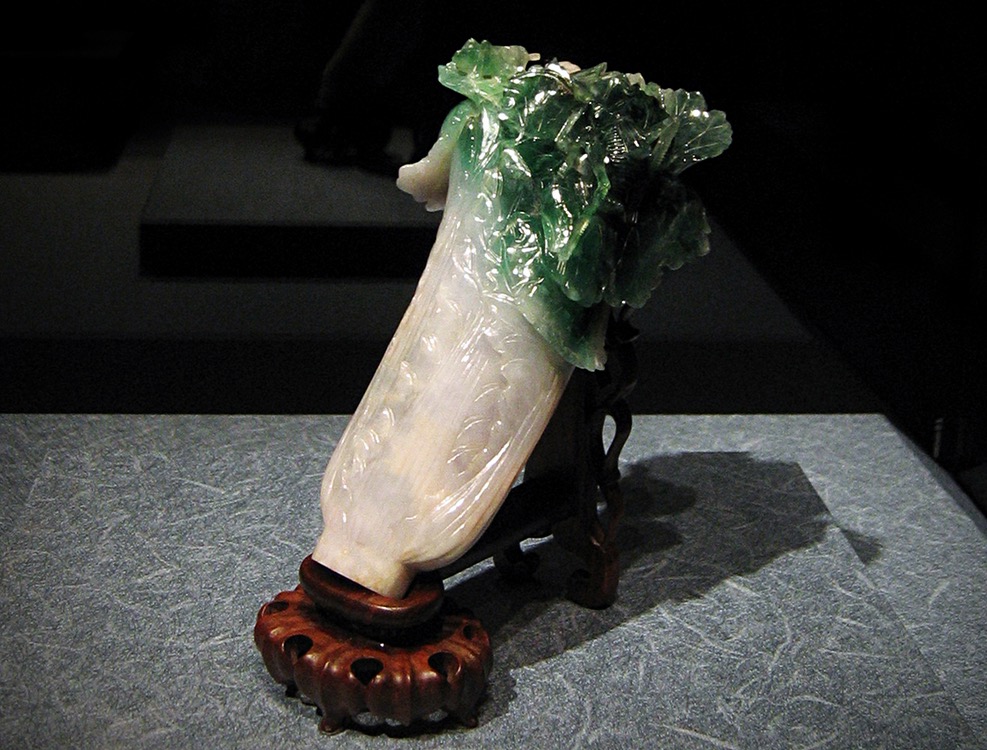
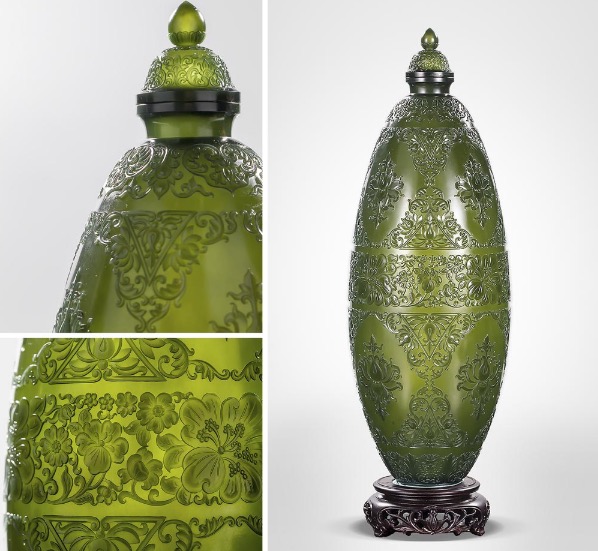
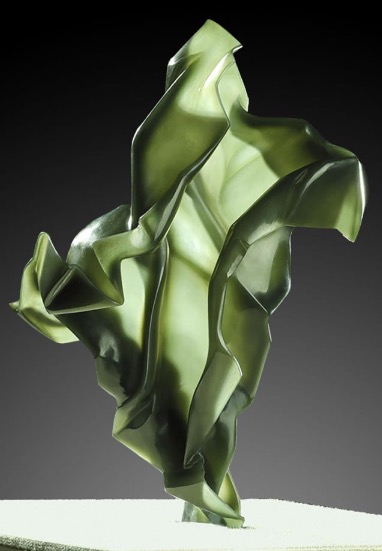
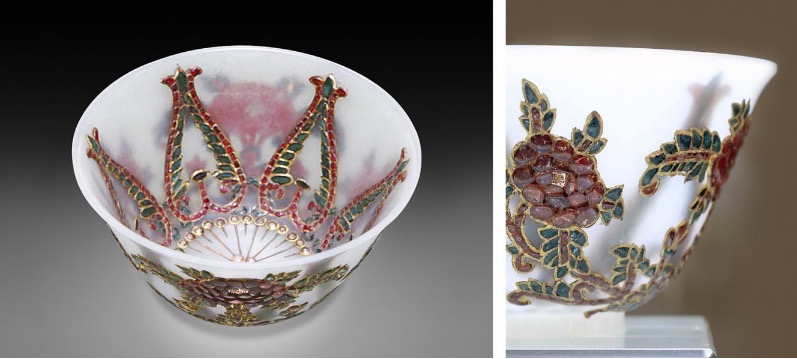
REFERENCES
Ref 2. https://www.gia.edu/doc/SP20-chinese-jade-carving-evolution.pdf
Ref 3. https://courses.lumenlearning.com/boundless-arthistory/chapter/the-neolithic-period/
Ref 4. https://en.wikipedia.org/wiki/Hongshan_culture
Ref 5. https://en.wikipedia.org/wiki/Liangzhu_culture
Ref 7. http://www.alaintruong.com/archives/2018/05/31/36449097.html
Ref 8. https://en.wikipedia.org/wiki/Xia_dynasty
Ref 9. https://en.wikipedia.org/wiki/Shang_dynasty
Ref 10. https://www.newworldencyclopedia.org/entry/Spring_and_Autumn_Period
Ref 11. https://veryimportantlot.com/en/lot/view/a-jade-human-face-ornament-shang-dynasty-1600-104-60278
Ref 12. https://en.wikipedia.org/wiki/Northern_and_Southern_dynasties
Ref 13. https://www.sothebys.com/en/auctions/ecatalogue/2017/chinese-art-hk0732/lot.309.html
Ref 14. https://www.jstor.org/stable/4101594?seq=5#metadata_info_tab_contents
Ref 16. https://en.wikipedia.org/wiki/Sui_dynasty
Ref 17. https://en.wikipedia.org/wiki/Tang_dynasty
Ref 20.
https://www.gia.edu/doc/Spring-1986-Gems-Gemology-Gemstone-Carving-China-Winds-Change.pdf
Ref 21. https://en.wikipedia.org/wiki/Jadeite_Cabbage
Ref 22. https://www.livehistoryindia.com/living-history/2019/06/09/the-romance-of-mughal-jade



